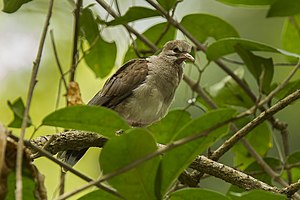Pigeon
| Pigeon | ||||||||||
|---|---|---|---|---|---|---|---|---|---|---|

Pigeon |
||||||||||
| Systematics | ||||||||||
|
||||||||||
| Scientific name | ||||||||||
| Leptotila pallida | ||||||||||
| Berlepsch & Taczanowski , 1884 |
The pigeon ( Leptotila pallida ) is a species of pigeon birds. It occurs exclusively in northern South America. It is considered to be safe in terms of its existence ( least concern ).
Appearance
The pigeon reaches a body length between 23 and 26 centimeters.
The males have a gray-white front head, the crown is light gray. The nape and the back of the neck are gray with a wine-red tint. The coat is reddish gray and has an iridescent shimmer . The wing covers, the wings, the back, the rump and the upper tail coverts are reddish brown to maroon brown. The small elytra are washed out reddish.
The chin and throat are white and merge with a pale white pink on the sides of the neck and on the chest. The belly and the underside of the tail are white. The under tail-coverts are blackish with broad white tips. The iris is straw yellow. The featherless skin around the eyes is crimson. The beak is black. The feet and legs are coral red.
The females are generally a little more dull in color. The young birds, on the other hand, are darker. The feathers of the wing covers still have isabel-colored hems. Their feet and legs are still dull red.
voice
The call of the pale dove is a short, melancholy-looking huuu ... that ends abruptly and is reminiscent of the sound that is produced when you blow over the opening of a bottle. It sounds similar to the call of the red ax pigeon , but is slightly higher.
Possible confusion
There are several other types of sound swinging pigeons in the distribution area of the pale pigeon, with which it could be confused. The white-foreheaded pigeon lives in regions that are drier than the habitat of the pale pigeon and have a sparser tree population. The subspecies found in Colombia and Ecuador is also paler than the pigeon and has more uniform plumage.
The gray-headed pigeon can hardly be distinguished from the pale pigeon when observing the field. It has more gray parts on the neck and on the coat than the pale dove and has a darker chest, the flanks are more intense isabel-colored.
The yellow-bellied pigeon is smaller than the pale pigeon and has darker plumage. it is also cinnamon colored on the chest.
Distribution area and habitat
The distribution area of the pigeon is limited to the Colombian Departamento del Chocó and Ecuador. In the entire distribution area, the natural forests were cut down to create plantations, which has made the pigeons less common. They are only found in isolated forest areas, especially in western Ecuador. Due to the very large distribution area, the pigeon is classified by the IUCN as overall safe.
The habitat are tropical forests from the lowlands to altitudes of 800 meters. It is very rarely found on agricultural land.
Way of life
The pigeon is a resident bird that lives on the ground and only flies up when threatened. They live in pairs or individually and find their food in the leafy layer that loves the ground in the undergrowth of forests or on the edge of the forest. The food spectrum used by her has not yet been conclusively investigated. But it probably eats seeds, small fruits and animal protein in the form of insects. Their reproductive biology has not yet been conclusively investigated either. However, pigeons whose physical condition indicates breeding mood were found towards the end of December. Their voices are also heard more frequently between November and January, indicating that their breeding season falls during this period.
literature
- David Gibbs, Eustace Barnes and John Cox: Pigeons and Doves - A Guide to the Pigeons and Doves of the World . Pica Press, Sussex 2001, ISBN 90-74345-26-3 .
- Alois Münst and Josef Wolters: Tauben - The species of wild pigeons , 2nd expanded and revised edition, Verlag Karin Wolters, Bottrop 1999, ISBN 3-9801504-9-6 .
- Gerhard Rösler: The wild pigeons of the earth - free living, keeping and breeding . M. & H. Schaper Verlag, Alfeld-Hannover 1996, ISBN 3-7944-0184-0 .
- Hans Hermann Carl Ludwig von Berlepsch, Władysław Taczanowski: List des Oiseaux recueillis par MM. Stolzmann et Siemiradzki dans L'Ecuadeur occidentale . In: Proceedings of Scientific Meeting of the Zoological Society of London for the Year 1883 . 1883, p. 536-577 ( biodiversitylibrary.org ).
Web links
- Leptotila pallida inthe IUCN Red List of Threatened Species 2016.1. Posted by: BirdLife International, 2016. Retrieved December 19, 2016.
- Call of the pale dove on Xeno-Canto
- Pigeon on Avibase
- Handbook of the Birds of the World: Photos
Single receipts
- ↑ a b Leptotila pallida in the Red List of Threatened Species of the IUCN 2016.1. Posted by: BirdLife International, 2016. Retrieved December 19, 2016.
- ↑ a b c Gibbs, Barnes and Cox: Pigeons and Doves , p. 366.
- ↑ Call of the pale dove on Xeno-Canto , accessed on December 19, 2016